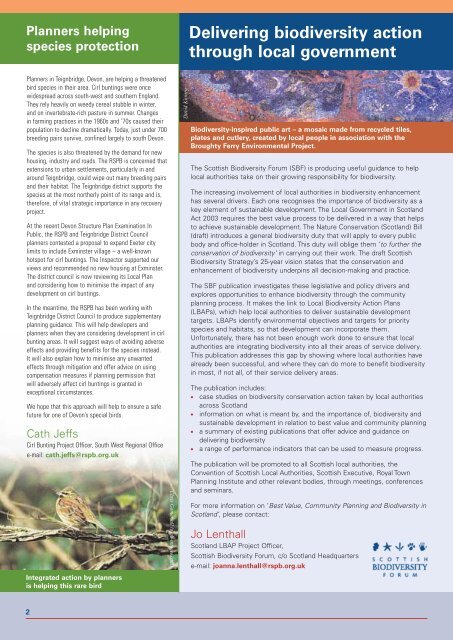Conservation Planner 20 - RSPB
Conservation Planner 20 - RSPB
Conservation Planner 20 - RSPB
Create successful ePaper yourself
Turn your PDF publications into a flip-book with our unique Google optimized e-Paper software.
<strong>Planner</strong>s helping<br />
species protection<br />
Delivering biodiversity action<br />
through local government<br />
<strong>Planner</strong>s in Teignbridge, Devon, are helping a threatened<br />
bird species in their area. Cirl buntings were once<br />
widespread across south-west and southern England.<br />
They rely heavily on weedy cereal stubble in winter,<br />
and on invertebrate-rich pasture in summer. Changes<br />
in farming practices in the 1960s and ‘70s caused their<br />
population to decline dramatically. Today, just under 700<br />
breeding pairs survive, confined largely to south Devon.<br />
The species is also threatened by the demand for new<br />
housing, industry and roads. The <strong>RSPB</strong> is concerned that<br />
extensions to urban settlements, particularly in and<br />
around Teignbridge, could wipe out many breeding pairs<br />
and their habitat. The Teignbridge district supports the<br />
species at the most northerly point of its range and is,<br />
therefore, of vital strategic importance in any recovery<br />
project.<br />
At the recent Devon Structure Plan Examination In<br />
Public, the <strong>RSPB</strong> and Teignbridge District Council<br />
planners contested a proposal to expand Exeter city<br />
limits to include Exminster village – a well-known<br />
hotspot for cirl buntings. The Inspector supported our<br />
views and recommended no new housing at Exminster.<br />
The district council is now reviewing its Local Plan<br />
and considering how to minimise the impact of any<br />
development on cirl buntings.<br />
In the meantime, the <strong>RSPB</strong> has been working with<br />
Teignbridge District Council to produce supplementary<br />
planning guidance. This will help developers and<br />
planners when they are considering development in cirl<br />
bunting areas. It will suggest ways of avoiding adverse<br />
effects and providing benefits for the species instead.<br />
It will also explain how to minimise any unwanted<br />
effects through mitigation and offer advice on using<br />
compensation measures if planning permission that<br />
will adversely affect cirl buntings is granted in<br />
exceptional circumstances.<br />
We hope that this approach will help to ensure a safe<br />
future for one of Devon’s special birds.<br />
Cath Jeffs<br />
Cirl Bunting Project Officer, South West Regional Office<br />
e-mail: cath.jeffs@rspb.org.uk<br />
Integrated action by planners<br />
is helping this rare bird<br />
Chris Gomersall (rspb-images.com)<br />
David Kinney<br />
Biodiversity-inspired public art – a mosaic made from recycled tiles,<br />
plates and cutlery, created by local people in association with the<br />
Broughty Ferry Environmental Project.<br />
The Scottish Biodiversity Forum (SBF) is producing useful guidance to help<br />
local authorities take on their growing responsibility for biodiversity.<br />
The increasing involvement of local authorities in biodiversity enhancement<br />
has several drivers. Each one recognises the importance of biodiversity as a<br />
key element of sustainable development. The Local Government in Scotland<br />
Act <strong>20</strong>03 requires the best value process to be delivered in a way that helps<br />
to achieve sustainable development. The Nature <strong>Conservation</strong> (Scotland) Bill<br />
(draft) introduces a general biodiversity duty that will apply to every public<br />
body and office-holder in Scotland. This duty will oblige them ‘to further the<br />
conservation of biodiversity’ in carrying out their work. The draft Scottish<br />
Biodiversity Strategy’s 25-year vision states that the conservation and<br />
enhancement of biodiversity underpins all decision-making and practice.<br />
The SBF publication investigates these legislative and policy drivers and<br />
explores opportunities to enhance biodiversity through the community<br />
planning process. It makes the link to Local Biodiversity Action Plans<br />
(LBAPs), which help local authorities to deliver sustainable development<br />
targets. LBAPs identify environmental objectives and targets for priority<br />
species and habitats, so that development can incorporate them.<br />
Unfortunately, there has not been enough work done to ensure that local<br />
authorities are integrating biodiversity into all their areas of service delivery.<br />
This publication addresses this gap by showing where local authorities have<br />
already been successful, and where they can do more to benefit biodiversity<br />
in most, if not all, of their service delivery areas.<br />
The publication includes:<br />
● case studies on biodiversity conservation action taken by local authorities<br />
across Scotland<br />
● information on what is meant by, and the importance of, biodiversity and<br />
sustainable development in relation to best value and community planning<br />
● a summary of existing publications that offer advice and guidance on<br />
delivering biodiversity<br />
● a range of performance indicators that can be used to measure progress.<br />
The publication will be promoted to all Scottish local authorities, the<br />
Convention of Scottish Local Authorities, Scottish Executive, Royal Town<br />
Planning Institute and other relevant bodies, through meetings, conferences<br />
and seminars.<br />
For more information on ‘Best Value, Community Planning and Biodiversity in<br />
Scotland’, please contact:<br />
Jo Lenthall<br />
Scotland LBAP Project Officer,<br />
Scottish Biodiversity Forum, c/o Scotland Headquarters<br />
e-mail: joanna.lenthall@rspb.org.uk<br />
2

















